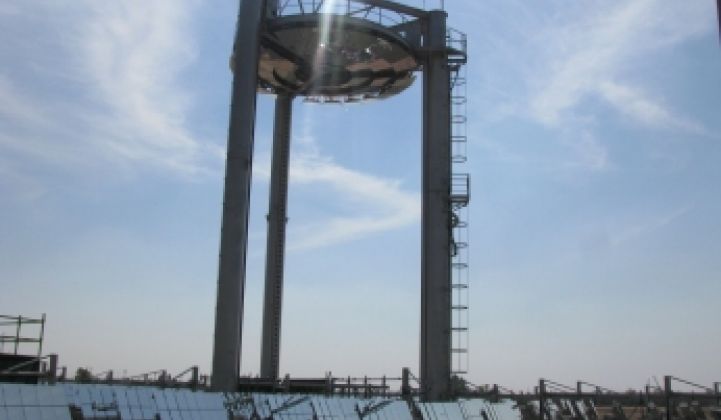Masdar City, Abu Dhabi -- Think of this as solar thermal with a bank shot.
Researchers at the Masdar Institute, the Tokyo Institute of Technology and Cosmo Oil have begun to test a new/old technology for converting heat from the sun into electricity that could further cut costs.
It works by adding another layer of mirrors to the process. In Masdar’s prototype, ground-based heliostats-i.e. flat mirrors -- concentrate heat from the sun and aim it at a tower. So far, that’s similar to the heliostat architectures promoted by BrightSource Energy and eSolar. But BrightSource and eSolar systems use tanks filled with fluid. When the fluid heats and expands, the pressure can be channeled to turn a turbine. In Masdar’s system, the tower holds another set of mirrors. These mirrors then take the heat from the heliostats and then reflect it to a liquid filled tank on the ground directly under the tower. Operating temperatures for the prototype come to around 500 Celsius, which is lower than BrightSource, higher than others, and improvements will occur. Appropriately, it's called the beam down project.
The extra set of mirrors reduces the efficiency to around 15 to 19 percent. Classic solar thermal systems are 20 plus percent efficient. But with the extra set of mirrors fluids don’t have to be pumped up into a tower, thereby reducing energy and cost, according to Mateo Chiesa, a professor at the Masdar Institute.
The current 10 meter high prototype and accompanying is still that: the liquid filled tanks haven’t even been installed yet. But Chiesa says that it should be capable of generating around 100 kilowatts. Larger versions could generate 10 megawatts or so and a field of these larger towers could then generate 50 to 100 megawatts.
"You don't need a conventional power plant to pump up transfer fluid," he said. "The overall idea is that you are more confined. The whole transfer from the receiver to the working fluid happens on the ground.
"It's a nice barbeque," he added.
It’s new in that no one is building solar thermal towers like this commercially at the moment. Masdar hopes to be the first. It’s old, however, in that others have tinkered with similar concepts in the past. Israel’s Weizmann Institute has a similar tower. Weizmann’s tower, however, contains a single, monolithic mirror, said Chiesa (who comes to Masdar, like a lot of people, from MIT.) Monolithic mirrors are more difficult to make and can heat and expand in the heat. Masdar’s consists of 48 independent mirrors made in conjunction with Konica Minolta. Independent mirrors can be cooled easier and can exploit ambient air although the immediate surrounding environment will be quite hot. It may not need liquid cooling, a goal a lot of solar thermal companies are inching toward and one that's especially important in an arid country. (For another unusual solar thermal device, check out HelioFocus.)
Will it work? Who knows. But it’s interesting. Here’s a video of the heliostats in action.



